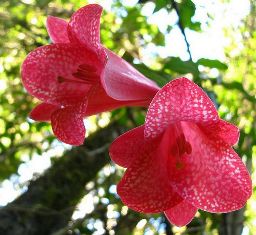Want to know more about the Chilean Bellflower? Read on for facts and info on the beautiful Chilean flowers found in abundance in the region…
This charming Chilean bellflower is from the Philesiaceae family but many gardeners are unfamiliar with the plant named Lapageria rosea to honor Empress Josephine of France, the wife of Napoleon Bonaparte who was also known as Tascher de la Pagerie. Deep in the misty Chilean rainforests, the moist undergrowth and super drainage soil allows this climbing evergreen lily to thrive.
As the sole species in its genus, this healthy vine has beautiful bell shaped flowers of up to 4 inches hanging from the upper area of the leaf axils. The six petal flower flares out into a large bell shape with the three on the exterior smaller in size and the inner three a large size. The standard color is rose crimson but the colors of the cultivars offer a myriad palette including blush, red, white, pink and are mottled or laced. There is a waxy cuticle on the surface of the flowers in different levels of thickness. The alternating leaves on the vines are oval and have a high gloss.
The Lapageria rosea or Chilean bellflower blooms from summer to late autumn. However, the Lapageria rosea ‘Toqui’ and ‘Collinge’ bloom through mid winter in city gardens. These delicate plants thrive in cool, frost-free climates and a good shaded garden site and soil are ideal conditions for this plant.
For ideal soil mix, follow this ‘recipe’ provided by Carlos Rendon the former Chilean Bellflower promoter at the Botanical Garden at the University of California. Combine 1/3 parts each of peat moss, leaf mold and medium bark chips to make loose soil to promote good drainage. The leaf mold which comprises of leaves crumbled into compost is a prime way of recycling garden material so you can substitute compost for leaf mold also. Nathan Smith, Rendon’s replacement thinks that you can combine items like perlite, bark, peat, gravel or sand can all offer a porous base.
You need to water the plant regularly and very deeply and add acid plant food on a monthly basis to allow the flowers to thrive and bloom. The vine requires adequate support and does not require pruning as the vine thrives on the previous growth. The Chilean bellflower can be propagated easily with cutting, fresh seedlings and layering techniques. The vine is prone to infestation with slugs or snails which can be kept at bay with Sluggo that is not injurious to children and pets.
The beautiful cultivars popular in San Fancisco hail from the University of California Botanical Garden. The white L. ‘Toqui’ flowers into waxy petal blooms in a shady nook in gardens. The ‘Ligtromu,’ is another white bloom and the Cream colored ‘Collinge,’ is laced with red and finally the warm red ‘Beatrix Anderson,’ is an English cultivar.The charm and ease of maintenance of this plant has led it to be crowned the national flower of Chile.





